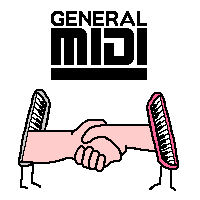|
Today's portable keyboards are packed with
amazingly-realistic "voices" (also called
"sounds" or "tones"). Just touch a button and your
keyboard sounds like a Honky Tonk piano, a mellow trombone, a
punchy banjo, a Xylophone, or a power rock drum kit. As well as
instrument voices, many keyboards offer cool voices such as applause, ocean waves,
a door creaking,
heart beat and so on. Number of
Voices
Most
portable keyboards come with at least the General
MIDI (GM) voices. This is an industry-standard
selection of 128 instrument voices and 47 percussion
voices covering the basics needed for playing most types
of music. Not all GM voices have identical
voices, but the basic selection is the same. Most
mid- to high-end portable keyboards go well beyond the
General MIDI voices offering hundreds
of additional variations, funky instruments, vocal effects (like Oohs
and Humming) and more ethnic instruments (like Rabab,
Gopichant and Shanai). Phew! These extended voices
are called GM2, XG, XGlite, XF and GS
(from Roland).

When shopping for your keyboard you
won't be able to listen to all the voices, so listen to
those you're
likely to use the most. For a keyboard to learn to play on or to accompany a singer,
for example, check out the piano voices. For house
of worship use, you'll probably want to listen to the organ and choir
voices. If you plan to be in a rock band later, you've
got to love the piano, electric piano and organ voices.
If a keyboard is "GM compatible" -- what
does that mean?
 It means that the keyboard has the General MIDI voices, plus circuitry which
allows the right information about tempo and other music elements to be
selected. This means that the keyboard will accurately reproduce any GM music
files that you load into your keyboard. This will become important if you're
planning on creating songs to send to your friends. You sure don't want your
awesome guitar solo to sound like a Kazoo on your friends keyboard! If you both
have GM-compatible keyboards, your song will playback properly with the
intended instrument sounds. GM-compatibility will also be important if you
purchase GM music files, like styles (more on this later) and songs to load
into your keyboard. The Internet has thousands of
song files available and you can rest assured that your keyboard will be able
to reproduce these files. It means that the keyboard has the General MIDI voices, plus circuitry which
allows the right information about tempo and other music elements to be
selected. This means that the keyboard will accurately reproduce any GM music
files that you load into your keyboard. This will become important if you're
planning on creating songs to send to your friends. You sure don't want your
awesome guitar solo to sound like a Kazoo on your friends keyboard! If you both
have GM-compatible keyboards, your song will playback properly with the
intended instrument sounds. GM-compatibility will also be important if you
purchase GM music files, like styles (more on this later) and songs to load
into your keyboard. The Internet has thousands of
song files available and you can rest assured that your keyboard will be able
to reproduce these files.
How do you know if a keyboard is GM compatible? The
GM logo is stamped on the keyboard itself. You can also
look for the XG logo on Yamaha keyboards, and the GS
logo on Roland keyboards. If one or more of these logos
is present, the keyboard is GM compatible.
Dual and Split
To enhance your performance options, many portable keyboards
offer dual and split modes. Pressing the Dual button
allows you to layer
and blend two sounds at the same time; piano and strings, for
example, is a popular option. Pressing the Split button
allows you to play a combination-instrument performance
such as funk bass with the left hand and electric piano
with the right hand. With hundreds of voices to choose from, the
combinations are only limited by your imagination. You can also select the split point on the keyboard.
Built-In Effects
Effects add ambience and dimension to the sounds and most portable
keyboards come with the common effects reverb and chorus. Reverb
simulates the sound of playing in a large concert hall (in your
living room!); chorus
adds a lush shimmering quality to the sound and can make a
single instrument sound like a group of players. The higher the
keyboard price, the
more effects you get.
When shopping, check if the keyboard's effects include a
"DSP." This is a digital signal processor which
enables a collection of amazing effect goodies, ranging from distortion
(essential for that hip electric guitar sound) and delay
(which echoes the sound) to rotary speaker (great for
organ sounds) and much more. If you want to spice up your
melody, look out for a harmony
effect, which adds a variety of harmonies (extra notes) to your
right-hand playing. And if that's not enough for you, some
keyboards include an equalizer (EQ),
allowing you to boost (or suppress) certain frequencies of a
sound to tailor it to
suit your music.
|
|
